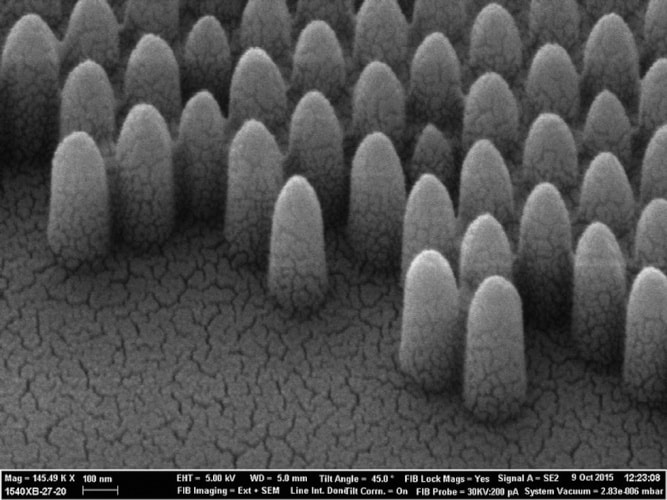
Buildings consume 40 per cent of the energy used in the developed world, with heating and cooling accounting for around two-thirds of this.
The smart windows, which have been developed at University College London (UCL) with funding from EPSRC, could help reduce the cost of cleaning the large number of windows in modern office buildings, cut energy use and slash heating bills by up to 40 per cent.
The windows are engraved with a series of pencil-like conical nanostructures. These trap air and ensure only a tiny amount of water touches the surface of the glass.
As a result, any rain hitting the windows forms into spherical droplets that simply roll off the glass surface, picking up dust and dirt in their path as they do so.
In contrast, raindrops hitting conventional windows cling to the glass, causing them to slide down it and leave streaks and dirt behind.
The pattern of the nanostructures also gives the windows the same anti-reflective properties as the eyes of creatures such as moths, which allow them to hide from predators. This reduces glare by cutting the amount of light reflected internally within a room, to less than five per cent. This compares with 20-30 per cent for other prototype energy saving windows.
Finally, the nanostructured windows are then coated with a thin film of vanadium dioxide on top. This prevents heat escaping from the building on cold days, and stops infrared radiation from sunlight passing through the glass on hot days.
That is because vanadium dioxide is a thermochromic material, meaning it can switch from blocking all infrared radiation to allowing it to pass through, depending on the temperature applied to it.
Unlike the gold or silver coatings used in some smart windows, vanadium dioxide is a cheap and abundant material. What’s more, only a very thin layer of between 5-10 nanometres of the material is needed, making it more cost-effective and sustainable than other technologies.
The windows are the first to combine this thin thermochromic coating with a nanostructure engraving, according to the project leader Dr Ioannis Papakonstantinou at UCL.
The two technologies complement each other, with the nanostructure helping to enhance the thermochromic properties of the coating, he said.
That is because unlike smooth films of vanadium dioxide, which require a very large area to achieve a thermochromic effect, the nanostructures increase the surface area of the film significantly. “If you compare the [surface] area of planar films with our nanostructured material, you will see that we have enhanced the area by over ten times,” he said.
This means only a very thin layer is needed to achieve the same effect as much thicker smooth films, he said.
The researchers are in discussions with UK glass manufacturers in a bid to commercialise the smart windows. This will involve scaling up the manufacturing methods the researchers have developed to produce the nanostructured glass, as well as the coating process used.
If these discussions are successful, the researchers believe the smart windows could be commercially available within three to five years. They have been awarded a five-year European Research Council grant to build the windows and test them under realistic conditions.
Meanwhile, the team is also hoping to develop a smart polymer film incorporating the nanostructures, which could be applied to existing windows to offer the same self-cleaning and energy-saving benefits.




Nanogenerator consumes CO2 to generate electricity
Whoopee, they've solved how to keep a light on but not a lot else.